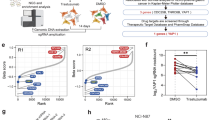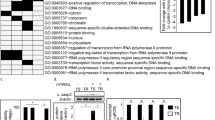Abstract
Purpose
Tumor necrosis factor (TNF)-related apoptosis-inducing ligand (TRAIL) is well known for its unique ability to induce apoptosis in cancer cells but not normal cells. However, a subpopulation of cancer cells exist that does not respond to toxic doses of TRAIL. In this study, we aimed to identify key factors regulating TRAIL resistance in breast cancer.
Methods
rhTRAIL (recombinant human TRAIL) resistant cells (TR) isolated from TRAIL sensitive MDA-MB-231 parental cells (TS) were confirmed using trypan blue assay, cell viability assay and AO/EtBr (acridine orange/ethidium bromide) staining. Microarray was performed followed by analysis using DAVID and Cytoscape bioinformatics software to identify the candidate hub gene. Gene expression of the candidate gene was confirmed using real-time PCR and western blot. Candidate gene was overexpressed via transient transfection to identify its significance in the context of rhTRAIL. Breast cancer patient data was obtained from The Cancer Genome Atlas (TCGA) database.
Results
Whole transcriptome analysis identified 4907 differentially expressed genes (DEGs) between TS and TR cells. CDH1 was identified as the candidate hub gene, with 18-degree centrality. We further observed CDH1 protein to be downregulated, overexpression of which increased apoptosis in TR cells after rhTRAIL treatment. TCGA patient data analysis also showed CDH1 mRNA to be low in TRAIL resistant patient group compared to TRAIL sensitive group.
Conclusion
CDH1 overexpression sensitizes TR cells towards rhTRAIL induced apoptosis. Therefore, we can hypothesize that CDH1 expression should be taken into account while performing TRAIL therapy in breast cancer.






Similar content being viewed by others
Availability of data and material
The microarray data that supports the findings of this study are available from the corresponding author, RP, upon reasonable request.
References
MacFarlane M (2003) TRAIL-induced signalling and apoptosis. Toxicol Lett 139(2–3):89–97. https://doi.org/10.1016/s0378-4274(02)00422-8
Lawrence D, Shahrokh Z, Marsters S et al (2001) Differential hepatocyte toxicity of recombinant Apo2L/TRAIL versions. Nat Med 7(4):383–385. https://doi.org/10.1038/86397
Almasan A, Ashkenazi A (2003) Apo2L/TRAIL: apoptosis signaling, biology, and potential for cancer therapy. Cytokine Growth Factor Rev 14(3–4):337–348. https://doi.org/10.1016/s1359-6101(03)00029-7
Paul T, Banerjee A, Reddy SVB, Mahato SK, Biswas N (2019) Hydroxychavicol sensitizes imatinib-resistant chronic myelogenous leukemia cells to TRAIL-induced apoptosis by ROS-mediated IAP downregulation. Anticancer Drugs 30(2):167–178. https://doi.org/10.1097/CAD.0000000000000710
LeBlanc H, Lawrence D, Varfolomeev E et al (2002) Tumor-cell resistance to death receptor–induced apoptosis through mutational inactivation of the proapoptotic Bcl-2 homolog Bax. Nat Med 8(3):274–281. https://doi.org/10.1038/nm0302-274
Spencer SL, Gaudet S, Albeck JG, Burke JM, Sorger PK (2009) Non-genetic origins of cell-to-cell variability in TRAIL-induced apoptosis. Nature 459(7245):428–432. https://doi.org/10.1038/nature08012
Zhang Y, Zhang B (2008) TRAIL resistance of breast cancer cells is associated with constitutive endocytosis of death receptors 4 and 5. Mol Cancer Res 6(12):1861–1871. https://doi.org/10.1158/1541-7786.MCR-08-0313
Lee TJ, Lee JT, Park JW, Kwon TK (2006) Acquired TRAIL resistance in human breast cancer cells are caused by the sustained cFLIP(L) and XIAP protein levels and ERK activation. Biochem Biophys Res Commun 351(4):1024–1030. https://doi.org/10.1016/j.bbrc.2006.10.163
Yoshida T, Zhang Y, Rivera Rosado LA, Zhang B (2009) Repeated treatment with subtoxic doses of TRAIL induces resistance to apoptosis through its death receptors in MDA-MB-231 breast cancer cells. Mol Cancer Res 7(11):1835–1844. https://doi.org/10.1158/1541-7786.MCR-09-0244
Snajdauf M, Havlova K, Vachtenheim J Jr et al (2021) The TRAIL in the treatment of human cancer: an update on clinical trials. Front Mol Biosci 8:628332. https://doi.org/10.3389/fmolb.2021.628332
Zhong HH, Wang HY, Li J, Huang YZ (2019) TRAIL-based gene delivery and therapeutic strategies. Acta Pharmacol Sin 40(11):1373–1385. https://doi.org/10.1038/s41401-019-0287-8
Montinaro A, Walczak H (2023) Harnessing TRAIL-induced cell death for cancer therapy: a long walk with thrilling discoveries. Cell Death Differ 30(2):237–249. https://doi.org/10.1038/s41418-022-01059-z
Twomey JD, Kim SR, Zhao L, Bozza WP, Zhang B (2015) Spatial dynamics of TRAIL death receptors in cancer cells. Drug Resist Updates 19:13–21. https://doi.org/10.1016/j.drup.2015.02.001
Bin L, Thorburn J, Thomas LR, Clark PE, Humphreys R, Thorburn A (2007) Tumor-derived mutations in the TRAIL receptor DR5 inhibit TRAIL signaling through the DR4 receptor by competing for ligand binding. J Biol Chem 282(38):28189–28194. https://doi.org/10.1074/jbc.M704210200
Korsmeyer SJ (1992) Bcl-2 initiates a new category of oncogenes: regulators of cell death. Blood 80(4):879–886
Youle RJ, Strasser A (2008) The BCL-2 protein family: opposing activities that mediate cell death. Nat Rev Mol Cell Biol 9(1):47–59. https://doi.org/10.1038/nrm2308
Verhagen AM, Ekert PG, Pakusch M et al (2000) Identification of DIABLO, a mammalian protein that promotes apoptosis by binding to and antagonizing IAP proteins. Cell 102(1):43–53. https://doi.org/10.1016/s0092-8674(00)00009-x
Aggarwal BB, Bhardwaj U, Takada Y (2004) Regulation of TRAIL-induced apoptosis by ectopic expression of antiapoptotic factors. Vitam Horm 67:453–483. https://doi.org/10.1016/S0083-6729(04)67023-3
Duiker EW, Mom CH, de Jong S et al (2006) The clinical trail of TRAIL. Eur J Cancer 42(14):2233–2240. https://doi.org/10.1016/j.ejca.2006.03.018
Peyre L, Meyer M, Hofman P, Roux J (2021) TRAIL receptor-induced features of epithelial-to-mesenchymal transition increase tumour phenotypic heterogeneity: potential cell survival mechanisms. Br J Cancer 124(1):91–101. https://doi.org/10.1038/s41416-020-01177-w
Ouyang W, Yang C, Zhang S et al (2013) Absence of death receptor translocation into lipid rafts in acquired TRAIL-resistant NSCLC cells. Int J Oncol 42(2):699–711. https://doi.org/10.3892/ijo.2012.1748
Lu M, Marsters S, Ye X, Luis E, Gonzalez L, Ashkenazi A (2014) E-cadherin couples death receptors to the cytoskeleton to regulate apoptosis. Mol Cell 54(6):987–998. https://doi.org/10.1016/j.molcel.2014.04.029
Fritsche H, Heilmann T, Tower RJ et al (2015) TRAIL-R2 promotes skeletal metastasis in a breast cancer xenograft mouse model. Oncotarget 6(11):9502–9516. https://doi.org/10.18632/oncotarget.3321
Liu C, Qi M, Li L, Yuan Y, Wu X, Fu J (2020) Natural cordycepin induces apoptosis and suppresses metastasis in breast cancer cells by inhibiting the Hedgehog pathway. Food Funct 11(3):2107–2116. https://doi.org/10.1039/c9fo02879j
Kim SH, Kim K, Kwagh JG et al (2004) Death induction by recombinant native TRAIL and its prevention by a caspase 9 inhibitor in primary human esophageal epithelial cells. J Biol Chem 279(38):40044–40052. https://doi.org/10.1074/jbc.M404541200
Szklarczyk D, Morris JH, Cook H et al (2017) The STRING database in 2017: quality-controlled protein-protein association networks, made broadly accessible. Nucleic Acids Res 45(D1):D362–D368. https://doi.org/10.1093/nar/gkw937
Tsai CJ, Ma B, Nussinov R (2009) Protein-protein interaction networks: how can a hub protein bind so many different partners? Trends Biochem Sci 34(12):594–600. https://doi.org/10.1016/j.tibs.2009.07.007
Liu K, Fu Q, Liu Y, Wang C (2019) An integrative bioinformatics analysis of microarray data for identifying hub genes as diagnostic biomarkers of preeclampsia. Biosci Rep. https://doi.org/10.1042/BSR20190187
Tomczak K, Czerwinska P, Wiznerowicz M (2015) The Cancer Genome Atlas (TCGA): an immeasurable source of knowledge. Contemp Oncol 19(1A):A68-77. https://doi.org/10.5114/wo.2014.47136
Gao J, Aksoy BA, Dogrusoz U et al (2013) Integrative analysis of complex cancer genomics and clinical profiles using the cBioPortal. Sci Signal. 6(269):pl1. https://doi.org/10.1126/scisignal.2004088
Cerami E, Gao J, Dogrusoz U et al (2012) The cBio cancer genomics portal: an open platform for exploring multidimensional cancer genomics data. Cancer Discov 2(5):401–404. https://doi.org/10.1158/2159-8290.CD-12-0095
Shan W, Jiang Y, Yu H et al (2017) HDAC2 overexpression correlates with aggressive clinicopathological features and DNA-damage response pathway of breast cancer. Am J Cancer Res 7(5):1213–1226
Kim SY, Kawaguchi T, Yan L, Young J, Qi Q, Takabe K (2017) Clinical relevance of microRNA expressions in breast cancer validated using the Cancer Genome Atlas (TCGA). Ann Surg Oncol 24(10):2943–2949. https://doi.org/10.1245/s10434-017-5984-2
Oldham S, Fulcher B, Parkes L, Arnatkevic Iute A, Suo C, Fornito A (2019) Consistency and differences between centrality measures across distinct classes of networks. PLoS ONE 14(7):e0220061. https://doi.org/10.1371/journal.pone.0220061
Paik S, Shak S, Tang G et al (2004) A multigene assay to predict recurrence of tamoxifen-treated, node-negative breast cancer. N Engl J Med 351(27):2817–2826. https://doi.org/10.1056/NEJMoa041588
Pal R, Srivastava N, Chopra R et al (2010) Investigation of DNA damage response and apoptotic gene methylation pattern in sporadic breast tumors using high throughput quantitative DNA methylation analysis technology. Mol Cancer 9:303. https://doi.org/10.1186/1476-4598-9-303
Pal R, Gochhait S, Chattopadhyay S et al (2011) Functional implication of TRAIL -716 C/T promoter polymorphism on its in vitro and in vivo expression and the susceptibility to sporadic breast tumor. Breast Cancer Res Treat 126(2):333–343. https://doi.org/10.1007/s10549-010-0900-5
Stuckey DW, Shah K (2013) TRAIL on trial: preclinical advances in cancer therapy. Trends Mol Med 19(11):685–694. https://doi.org/10.1016/j.molmed.2013.08.007
Zhang L, Fang B (2005) Mechanisms of resistance to TRAIL-induced apoptosis in cancer. Cancer Gene Ther 12(3):228–237. https://doi.org/10.1038/sj.cgt.7700792
Rahman M, Davis SR, Pumphrey JG et al (2009) TRAIL induces apoptosis in triple-negative breast cancer cells with a mesenchymal phenotype. Breast Cancer Res Treat 113(2):217–230. https://doi.org/10.1007/s10549-008-9924-5
Ralff MD, Kline CLB, Kucukkase OC et al (2017) ONC201 demonstrates antitumor effects in both triple-negative and non-triple-negative breast cancers through TRAIL-dependent and TRAIL-independent mechanisms. Mol Cancer Ther 16(7):1290–1298. https://doi.org/10.1158/1535-7163.MCT-17-0121
Greer YE, Gilbert SF, Gril B et al (2019) MEDI3039, a novel highly potent tumor necrosis factor (TNF)-related apoptosis-inducing ligand (TRAIL) receptor 2 agonist, causes regression of orthotopic tumors and inhibits outgrowth of metastatic triple-negative breast cancer. Breast Cancer Res 21(1):27. https://doi.org/10.1186/s13058-019-1116-1
Shen Y, Schmidt BUS, Kubitschke H et al (2020) Detecting heterogeneity in and between breast cancer cell lines. Cancer Converg 4(1):1. https://doi.org/10.1186/s41236-020-0010-1
Norton KA, Popel AS, Pandey NB (2015) Heterogeneity of chemokine cell-surface receptor expression in triple-negative breast cancer. Am J Cancer Res 5(4):1295–1307
Song MS, Carracedo A, Salmena L et al (2011) Nuclear PTEN regulates the APC-CDH1 tumor-suppressive complex in a phosphatase-independent manner. Cell 144(2):187–199. https://doi.org/10.1016/j.cell.2010.12.020
Sarrio D, Moreno-Bueno G, Hardisson D et al (2003) Epigenetic and genetic alterations of APC and CDH1 genes in lobular breast cancer: relationships with abnormal E-cadherin and catenin expression and microsatellite instability. Int J Cancer 106(2):208–215. https://doi.org/10.1002/ijc.11197
Christgen M, Bartels S, van Luttikhuizen JL et al (2020) E-cadherin to P-cadherin switching in lobular breast cancer with tubular elements. Mod Pathol. https://doi.org/10.1038/s41379-020-0591-3
Berx G, Becker KF, Hofler H, van Roy F (1998) Mutations of the human E-cadherin (CDH1) gene. Hum Mutat 12(4):226–237. https://doi.org/10.1002/(SICI)1098-1004(1998)12:4%3c226::AID-HUMU2%3e3.0.CO;2-D
Porter AG, Janicke RU (1999) Emerging roles of caspase-3 in apoptosis. Cell Death Differ 6(2):99–104. https://doi.org/10.1038/sj.cdd.4400476
Acknowledgements
This work was supported by the Department of Science and Technology - Science and Engineering Research Board (DST-SERB) under grant number EMR/2014/001009 to Dr. Ranjana Pal and Dr. Nabendu Biswas. P.T., A.P. and N.G. were supported by fellowship from Department of Science and Technology - Innovation in Science Pursuit for Inspired Research (DST-INSPIRE), Department of Science and Technology - Science and Engineering Research Board (DST-SERB) and Council of Scientific & Industrial Research - National Eligibility Test (CSIR-NET) fellowship, respectively. Infrastructure support was made possible with funds from the Presidency University, Department of Biotechnology - Boost to University Interdisciplinary Life Science Departments for Education and Research programme (DBT-BUILDER) and Department of Science and Technology - Fund for Improvement of S&T Infrastructure (DST-FIST)
Funding
This work was supported by the Department of Science and Technology - Science and Engineering Research Board (DST-SERB) under grant number EMR/2014/001009 to Dr. Ranjana Pal and Dr. Nabendu Biswas. P.T., A.P. and N.G. were supported by fellowship from Department of Science and Technology - Innovation in Science Pursuit for Inspired Research (DST-INSPIRE), Department of Science and Technology - Science and Engineering Research Board (DST-SERB) and Council of Scientific & Industrial Research - National Eligibility Test (CSIR-NET) fellowship, respectively. Infrastructure support was made possible with funds from the Presidency University, Department of Biotechnology - Boost to University Interdisciplinary Life Science Departments for Education and Research programme (DBT-BUILDER) and Department of Science and Technology - Fund for Improvement of S&T Infrastructure (DST-FIST).
Author information
Authors and Affiliations
Contributions
Conceived and designed the experiments: RP, NB. Performed the experiments: PT AP NG TP. Analyzed the data: PT RP NB. Analyzed TCGA data: PT RP BK. Wrote the paper: PT RP.
Corresponding author
Ethics declarations
Competing interest
The authors declare they have no financial interests.
Ethics approval
This study does not require ethics approval since no human or animal subjects were used for the experiment.
Additional information
Publisher's Note
Springer Nature remains neutral with regard to jurisdictional claims in published maps and institutional affiliations.
Supplementary Information
Below is the link to the electronic supplementary material.
Rights and permissions
Springer Nature or its licensor (e.g. a society or other partner) holds exclusive rights to this article under a publishing agreement with the author(s) or other rightsholder(s); author self-archiving of the accepted manuscript version of this article is solely governed by the terms of such publishing agreement and applicable law.
About this article
Cite this article
Tapadar, P., Pal, A., Ghosal, N. et al. CDH1 overexpression sensitizes TRAIL resistant breast cancer cells towards rhTRAIL induced apoptosis. Mol Biol Rep 50, 7283–7294 (2023). https://doi.org/10.1007/s11033-023-08657-1
Received:
Accepted:
Published:
Issue Date:
DOI: https://doi.org/10.1007/s11033-023-08657-1




